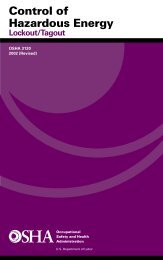Toxic Chemical Release Inventory Reporting Forms and Instructions
Toxic Chemical Release Inventory Reporting Forms and Instructions
Toxic Chemical Release Inventory Reporting Forms and Instructions
You also want an ePaper? Increase the reach of your titles
YUMPU automatically turns print PDFs into web optimized ePapers that Google loves.
Appendix D<br />
code is within SIC major group codes 10 (except<br />
1011, 1081, <strong>and</strong> 1094), 12 (except 1241); industry<br />
codes 4911 (limited to facilities that combust coal<br />
<strong>and</strong>/or oil for the purpose of generating power for<br />
distribution in commerce), 4931 (limited to facilities<br />
that combust coal <strong>and</strong>/or oil for the purpose of<br />
generating power for distribution in commerce), or<br />
4939 (limited to facilities that combust coal <strong>and</strong>/or<br />
oil for the purpose of generating power for<br />
distribution in commerce); or 4953 (limited to<br />
facilities regulated under the Resource Conservation<br />
<strong>and</strong> Recovery Act, subtitle C, 42 U.S.C. Section<br />
6921 et seq.) or 5169, or 5171, or 7389 (limited to<br />
facilities primarily engaged in solvents recovery<br />
services on a contract or fee basis).<br />
(3) If claiming a specific EPCRA section 313 chemical<br />
identity a trade secret, you should record why the<br />
EPCRA section 313 chemical identity is considered a<br />
trade secret <strong>and</strong> the appropriateness of the generic<br />
chemical name provided in the notification; <strong>and</strong><br />
(4) If claiming a specific concentration a trade secret, you<br />
should record explanations of why a specific<br />
concentration is considered a trade secret <strong>and</strong> the basis<br />
for the upper bound concentration limit.<br />
Information retained under 40 CFR 372 must be readily<br />
available for inspection by EPA.<br />
Trade Secrets<br />
<strong>Chemical</strong> suppliers may consider the chemical name or the<br />
specific concentration of an EPCRA section 313 chemical in<br />
a mixture or other trade name product to be a trade secret. If<br />
you consider the:<br />
(1) Specific identity of an EPCRA section 313 chemical to be<br />
a trade secret, the notice must contain a generic chemical<br />
name that is descriptive of the structure of that EPCRA<br />
section 313 chemical. For example, decabromodiphenyl<br />
oxide could be described as a halogenated aromatic.<br />
(2) Specific percentage by weight of an EPCRA section 313<br />
chemical in the mixture or other trade name product to be<br />
a trade secret, your notice must contain a statement that<br />
the EPCRA section 313 chemical is present at a<br />
concentration that does not exceed a specified upper<br />
bound. For example, if a mixture contains 12 percent<br />
toluene <strong>and</strong> you consider the percentage a trade secret,<br />
the notification may state that the mixture contains<br />
toluene at no more than 15 percent by weight. The upper<br />
bound value chosen must be no larger than necessary to<br />
adequately protect the trade secret.<br />
If you claim this information to be trade secret, you must have<br />
documentation that provides the basis for your claim.<br />
Recordkeeping Requirements<br />
You are required to keep records for three years of the<br />
following:<br />
(1) Notifications sent to recipients of your mixture or other<br />
trade name product;<br />
(2) All supporting materials used to develop the notice;<br />
D–4 <strong>Toxic</strong>s <strong>Release</strong> <strong>Inventory</strong> <strong>Reporting</strong> <strong>Forms</strong> <strong>and</strong> <strong>Instructions</strong>
















